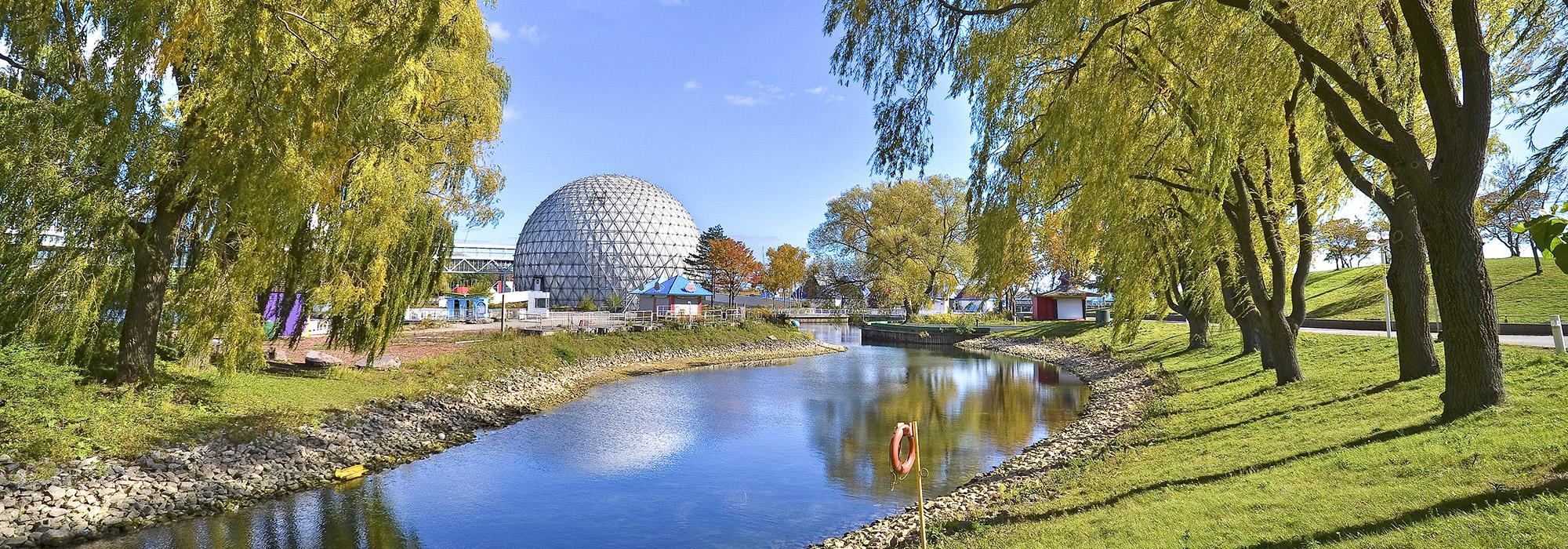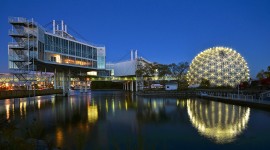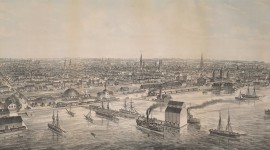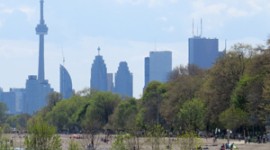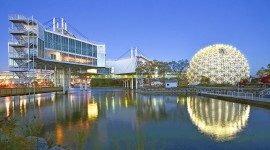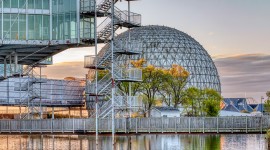Developers Invited to “Reinvent” Toronto’s Ontario Place
by Jane Wolff
Built on man-made islands just off the shore of Lake Ontario, Ontario Place is an imaginative and ambitious composition of architecture, engineering, and landscape architecture that opened to the public in 1971. Designed by architect Eberhard Zeidler and landscape architect Michael Hough, the Modernist waterfront park garnered international recognition and won several design awards. But now Ontario’s government has asked for proposals to “comprehensively develop and reinvent the site,” treating most of the recognized cultural heritage landscape as a tabula rasa.
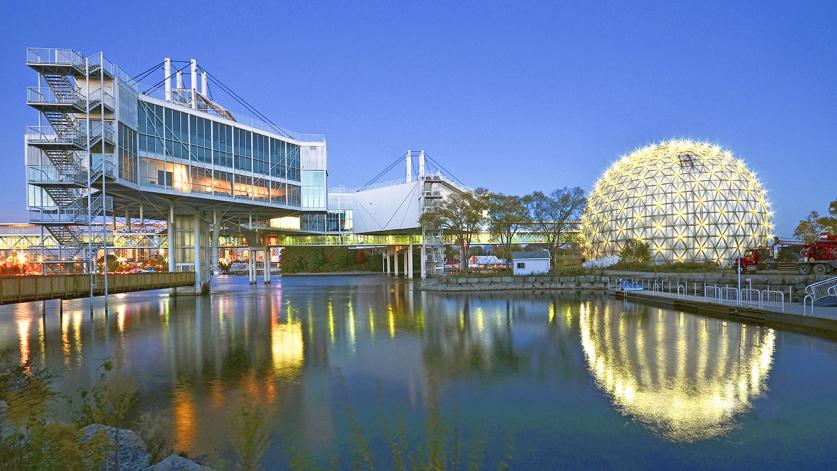
History
Buoyed by the recent success of the 1967 International and Universal Exposition in Montreal, the Honorable John Robarts, premier of Ontario, announced the bold vision for what would become Ontario Place in 1968. Given the task of reinvigorating a portion of shoreline on Toronto’s waterfront with a large, urban theme park, architect Eberhard Zeidler and landscape architect Michael Hough created a unique environment for experiencing exhibits, entertainment, and nature. Built by the Ontario Department of Trade and Development, the ensemble of interconnected landscape, architectural, and engineering features was conceived “as a showplace for the province’s identity, culture and economic growth.”
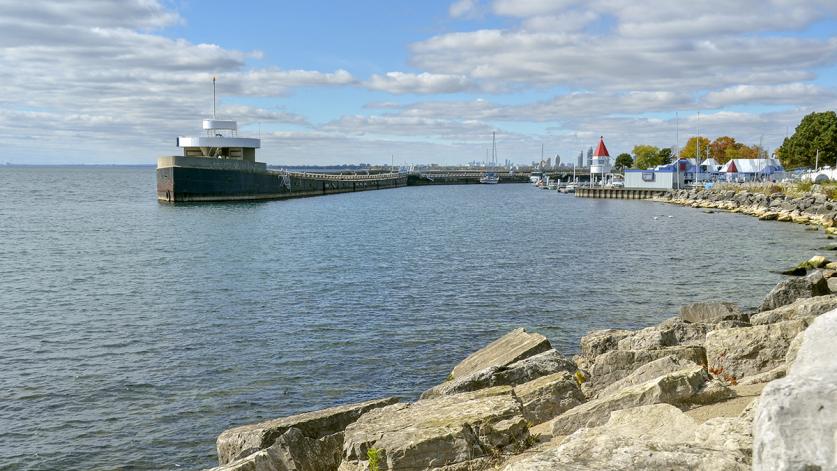
Ontario Place is formed by three artificial, barrier islands composed primarily of materials from the city landfill. Taking shape atop the man-made islands, the complex eventually encompassed some 155 acres—nearly 70 acres of land and 85 acres of water—carefully designed to form lagoons, a marina, and settings for entertainment and exhibitions. Accessible via bridges, the islands include a core of futuristic architectural elements enveloped by naturalistic woodlands, wetlands, and canals. By sinking three, obsolete Great Lakes freighters, a quarter-mile-long breakwater was formed around the southerly portion of the site, protecting the marina from storms. Five steel-and-aluminum “Pods” served as flexible exhibition spaces. Suspended over the water, the modular Pods were connected to a triodetic-domed structure, the Cinesphere, which housed the world’s first permanent IMAX theater. The Forum, designed by Hough on the central island, included a tented musical venue with a rotating stage, while the Children’s Village, designed by Eric McMillan, provided adventure play areas for younger visitors. A circuitous network of meandering paths traverses the islands, affording sequenced views of the architecture and the landscape, as well as dramatic prospects of the Toronto skyline and Lake Ontario. Zeidler later reflected on the importance of the landscape and Hough’s contributions to the project:
The result was islands and planting which looked as if God had been the landscape genius. From no one place could you see everything at once. One had to walk and explore. As you walked, you encountered different activities, and on the west shoreline there was simply quiet and solitude. The original Forum was nestled between trees to dovetail with the seating areas and the banks surrounding it to create a wonderful ambience for evening concerts…The concept was to create an urban park which, despite its density, would seem natural…Michael fulfilled this admirably.
The Forum’s musical venue was replaced by the much larger, 16,000-seat Molson Amphitheatre (now the Budweiser Stage) in 1994, destroying much of the intimate “valley” that Hough had created and felling more than 250 trees in the process. As visitation to Ontario Place waned and maintenance costs increased, the site continued to require annual government subsidies to operate. Once used as exhibition spaces, the Pods became private events facilities. Then, in 2012, Ontario Place was partially closed, with only the Budweiser Stage and the marina remaining in operation.
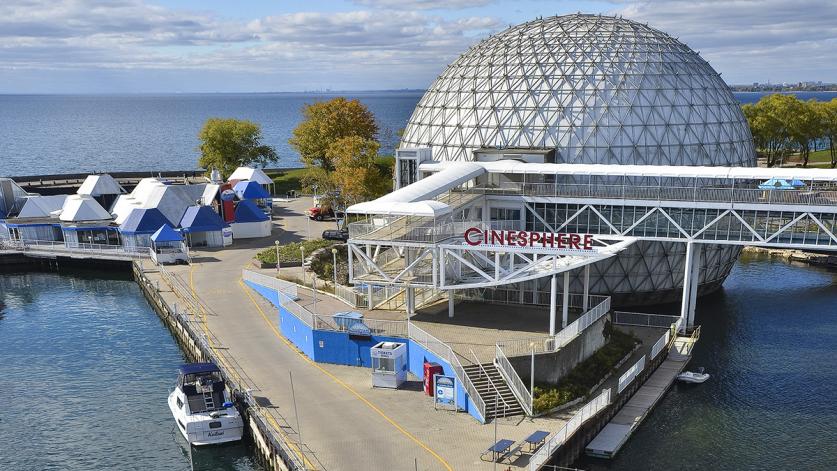
In 2014 Ontario’s Ministry of Culture, Tourism and Sport declared Ontario Place to be a "cultural heritage landscape of provincial significance" under the Ontario Heritage Act. At that time, the provincial government also announced its intention to keep Ontario Place as a publicly accessible park. In fact, work was then underway to design and build on the site what would become Trillium Park and the William G. Davis Trail, which opened in 2017. Located on the southeastern edge of East Island and designed by LANDinc and West 8, Trillium Park won the Award of Excellence from the Canadian Society of Landscape Architects in 2018.
Ontario Place is undeniably the work of two acknowledged masters of their professions. Michael Hough (1929 – 2013) studied under Ian McHarg at the University of Pennsylvania, earning his M.L.A. there before arriving with his family in Toronto in 1959. In 1963 Hough founded the Toronto-based Michael Hough & Associates, which would evolve through several partnerships before becoming ENVision-The Hough Group, in 2000. In addition to Ontario Place, his other notable projects include Humber Bay Shores Park in Etobicoke; an early plan for Don Valley Brickworks Park (now Evergreen Brick Works); and the Philosopher’s Walk, the University College Quadrangle, two courtyards of the Earth Sciences building, and the grounds of the Scarborough campus, all for the University of Toronto. Hough authored several books, including The Urban Landscape (1971) and Cities and Natural Process (1984), and in 1991 he co-authored an impactful report on restoring Toronto’s Don River. He was instrumental in founding the program in landscape architecture at the University of Toronto in 1965, and he served as president of the Canadian Society of Landscape Architects (CSLA) from 1985 to 1986. Among his many professional honors, Hough received the Lifetime Achievement Award from the CSLA in 1999.
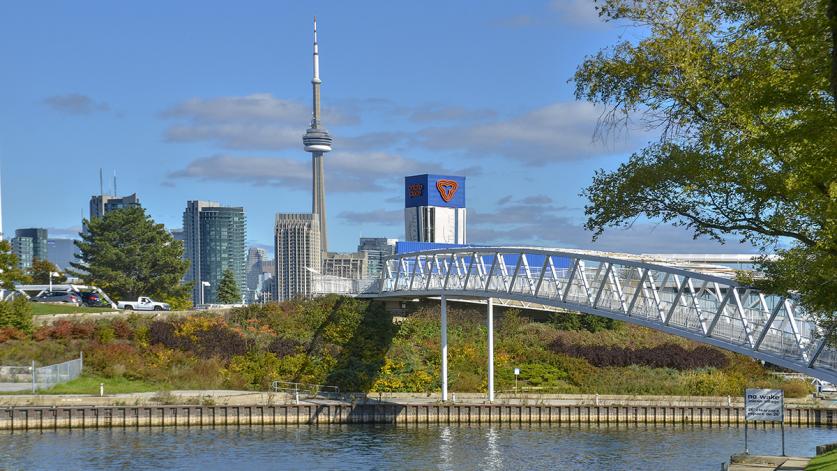
Another master practitioner, architect Ebderhard Zeidler has produced a long and varied list of exemplary works. Among them are Toronto’s Eaton Center, Vancouver’s Canada Place, the McMaster University Health Sciences Centre in Hamilton, and several innovative hospitals in Edmonton, Hamilton, and Saint John. In 1984 Zeidler was made an Officer of the Order of Canada. He has also received the Order of Ontario and, in 1986, won a medal from the Royal Architectural Institute of Canada. Ontario place, too, has been showered with awards, including the Canadian Architect Award of Excellence for projects in the design stage (1969); the American Iron and Steel Institute Design in Steel Citation for Excellence in Engineering (1973); a Merit Award in the Design category form the American Society of Landscape Architects (1975); the American Society of Interior Designers International Design Award (1975); the Design Excellence Award from the Ontario Association of Architects (1976); the 25-Year Award (now known as the Landmark Designation Award) from the Ontario Association of Architects (recognizing the Cinesphere and the Pods; 1999); and the National Trust Prix du XXe Siècle, from the National Trust for Canada, in partnership with the Royal Architectural Institute (2017).
Ontario Place has also been featured in a string of international journals, including Architectural Review, Architectural Design, Landscape Architecture Magazine, Domus, and Deutsche Bauzeitung. In 1994 the International Committee for the Documentation and Conservation of Buildings of the Modern Movement (DOCOMOMO International) listed the site on its inventory of significant international works of the Modern Movement.
Threat
In December 2018 the 42nd Parliament of Ontario passed legislation that repealed the Ontario Place Corporation Act, dissolving the public board overseeing management of Ontario Place and transferring all assets to the Crown for use by the Province. That same month, Jim Ginou, a Toronto businessman, political fundraiser, and associate of Premier Doug Ford, was appointed as chair of the board of Ontario Place. Mr. Ginou has been quoted as saying that the condition of Ontario Place is "disgraceful" and that "There is nothing that can be saved. Because it has to be rebuilt, it can be rebuilt in any way that [Premier] Ford wants it to be rebuilt."
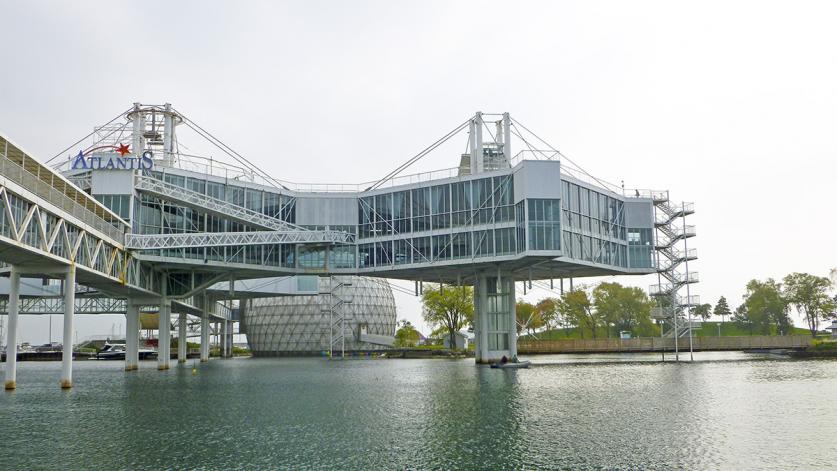
Soon thereafter, the Government of Ontario announced that it would seek new concepts to redevelop Ontario Place. The provincial government's stated vision for the site is to create "a world-class year round destination that will attract local, provincial and international visitors -with potential landmarks such as sports and entertainment attractions and retail." Toronto residents have had no input in the plan, and city officials were not consulted.
On April 12, 2019, the City of Toronto Heritage Preservation Services recommended in a report to City Council that Ontario Place be listed on the city’s Heritage Register, noting, in part:
Ontario Place, a cultural heritage landscape, remains a rare and intact Modernist expression of integrated architecture, engineering and landscape that honours and incorporates the natural setting of Lake Ontario. It was a remarkable and ambitious achievement of late twentieth century architecture, and holds an enduring influence in Toronto, the province and internationally.
The Toronto City Council then voted, 25-0, to add Ontario Place to the Register. It remains unclear, however, how much protection will be provided to the site, given that the Province owns much of the property. The listing does not offer any legal protections under the Ontario Heritage Act, which serves mostly as a symbolic gesture.
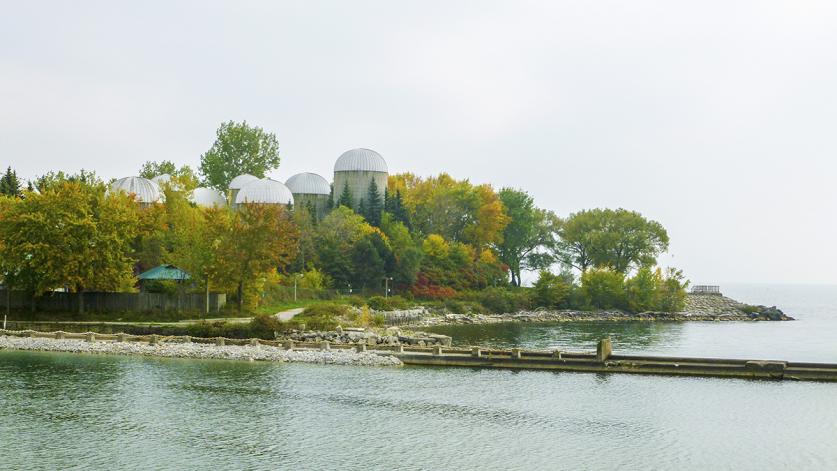
On May 28, 2019, Michael Tibollo (then serving as Ontario’s minister of tourism, culture and sport) announced a global call for submissions to privately develop the Ontario Place site. Minister Tibollo reassured the public that this redevelopment would not include residential units or casinos, although the majority of the site is open for redevelopment, including the entirety of the East Island, the West Island, the mainland, the Pod complex, and the Cinesphere. There are no limitations on the use and/or retention of existing assets on the site, with the exception of the Budweiser Stage. Minister Tibollo has reiterated in media statements that "all options are on the table" with respect to impacts on the Cinesphere and other heritage elements at the site.
With submissions due on September 3, 2019, the Call for Development further outlines the potential scope of the project and paints a vivid picture of the sweeping changes being sought. It states that the Government of Ontario is seeking “commercially-led solutions, with a strong focus on entertainment and leisure” and promises the opportunity to “comprehensively develop and reinvent the Site…” It also states that the “preference is for Submissions that are comprehensively planned and utilize the entire Site,” and that “There is no requirement for unrestricted public access. If necessary, access to all or portions of the Site can be controlled and should reflect the commercial requirements of the individual Submissions.” Moreover, the government is “committed to… accelerating the development process for its selected partners.”
What You Can Do to Help
The recently formed Ontario Place for All, a citizen-led advocacy group, has delineated several objectives and principles that it believes should govern the treatment of the site. In addition to calling for a public review of the project and for Ontario Place to remain publicly accessible, the group also seeks to ensure that its value as a cultural heritage landscape is recognized. Those wishing to add their support to these efforts can write or sign a letter that will reach Premier Doug Ford and Lisa MacLeod, Ontario’s minister of culture, tourism and sport.
Jane Wolff is an associate professor on the Daniels Faculty of Architecture, Landscape, and Design at the University of Toronto.



